Hokkaido’s History, Culture and Nature
Traditional Local Festivals and Folk Performing Arts
Various festivals are held and folk performing arts performed in various regions of the vast Hokkaido, and include festivals and folk performing arts handed down from the Matsumae clan period, those introduced from their hometowns by reclamation groups, as well as festivals that recently started as town revitalization projects in communities and have grown into established regular festivals in the community. These festivals and folk performing arts embody people’s spirits.
*With regard to the traditional festivals of the Ainu culture, please refer to Ainu culture: Prayer to Kamuy – Religion.
Traditions from the Edo period
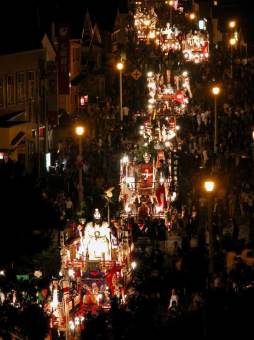
Held for three days from August 9 to 11. Included in the first Hokkaido heritage Selection as the prefecture’s oldest festival (Photo courtesy of Esashi Town)
In the coastal areas of Hokkaido, traditional festivals and folk performing arts have been handed down from the Edo period. These festivals and performing arts include activities involving herring fishing and those influenced by the festivals and performing arts in the Hokuriku region and the Kinai district (ancient Kyoto and surroundings), with which Hokkaido (Ezochi) had vigorous economic and cultural exchanges during the Edo period by way of the Kitamaebune cargo vessels.
The Ubagami Grand Shrine Festival is considered to date back to approximately 370 years ago, probably the oldest festival in Hokkaido. For three days from August 9 every year, a parade of 13 floats called yama move through the town with a portable shrine during the festival.
The oldest portable shrine at the Ubagami Grand Shrine was made in 1694. A significant influence of the Kinai region can particularly be seen in the Jingu Kogo doll of the Jinguyama float among the 13 floats. The doll is believed to have been brought by a Kyoto-based doll merchant during the Horeki era (1754–1762). The Ubagami Grand Shrine Festival is a representative event, not only of Hokkaido but also Japan for the splendor of the portable shrines and floats, the historical significance, and the passion of the local people concerning the festival.
The Fukushima Grand Shrine Festival is one of the oldest festivals in Hokkaido. The festival is said to date back to 1573. In 1897 the festival was already conducted in the current style of the event. An event called mikoshitogyo (carrying of a portable shrine through the community) during the festival features ritual processions, including a feudal lord’s procession (a.k.a. yakko gyoretsu) and the Shikasago procession.

Held on September 11 to 16. Matsumae Kagura (Shinto music and dance) on the eve and at the main festival is also worth seeing. (Photo courtesy of Fukushima Town)
Matsumae Kagura (Shinto music and dance) is famous as a traditional folk performing art representing the glories of the Matsumae clan period. The performing art is also called Oshiro Kagura because the art used to be performed in the castle (oshiro in Japanese). Matsumae Kagura is now performed in southern Hokkaido, the Shiribeshi region, including Otaru City, and the coastal area along the Sea of Japan, including Tomamae Town.
Traditional work and folk songs have remained popular to the present day. These songs that have taken root in the regions include Esashi Oiwake and Matsumae Oiwake, both of which were introduced as Oiwakebushi songs by the Kitamaebune cargo vessels, as well as herring fishing work songs, such as Soranbushi.
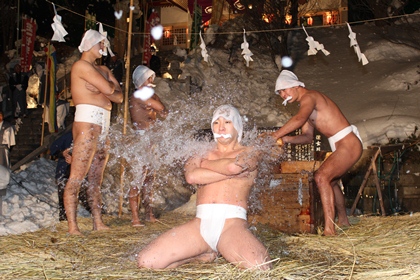
Held on January 13 to 15. Four young men holding four sacred objects perform ablutions in mid-winter after they have trained themselves by pouring cold water on them for many days. (Photo courtesy of Kikonai Town)
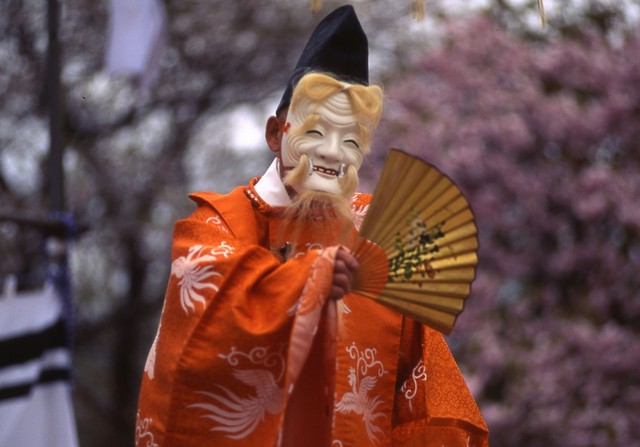
The origin of the Kagura (Shinto music and dance) is said to be an official event of the Matsumae Clan held in 1674 after the clan’s sixth lord Norihiro standardized the programs. (Photo courtesy of Matsumae Town Tourism Promotion Council)
Related links
Performing arts that have developed a unique Hokkaido character while traditional features are preserved
Groups of immigrants from various parts of Japan who settled in Hokkaido brought festivals and folk performing arts from their hometowns to their new settlements as something to turn to. Settlers from Toyama Prefecture where people had a deep faith in the True Pure Land Sect of Buddhism brought the lion dance as a related traditional community event to various parts of Hokkaido.
The Tadoshi lion dance, which has been handed down to the Tadoshi Shrine Festival in Fukagawa, represents the scene of two lions killing a wild boar. The dance is said to have originated in the Inotani district in Kamitaira Village, Higashitonami-gun, Toyama Prefecture. The Tadoshi lion dance resembles the original Toyama Prefecture dance more closely than any other lion dance in Hokkaido.
The Moseushi Shrine Festival in Moseushi Town is a unique Hokkaido event because features of the eastern and western parts of Japan are fused harmoniously. The features are exemplified by the Moseushi lion dance, which originated in Toyama Prefecture (eastern Japan), and Jigami Miya (Land Deity Shrine), which was introduced by settlers from the Shikoku region (western Japan). Muroran Kagura (Shinto music and dance) dates back to 1901 when Sanjo Kagura from Sanjo City, Niigata Prefecture was introduced to the Muroran Hachiman Shrine. Geishin no Mai, one of the 33 dances of the kagura was created and dedicated to the Muroran shrine in the early Showa era. This indicates that the traditional kagura from the mainland of Japan has taken root in the area while incorporating a new tradition into the performing art.
In August bon dances are performed on a large scale in various parts of Hokkaido. Hokkai Bon-uta is used as a song for many of the bon dances. The song originated from Betcho-bushi, which served as the accompaniment when miners and their families of the Ikushunbetsu Mine in Mikasa City danced. In 1940 Kozan Imai, folk song researcher, rewrote the original lyrics as Hokkaido Tanko-bushi to familiarize larger numbers of people with the song.
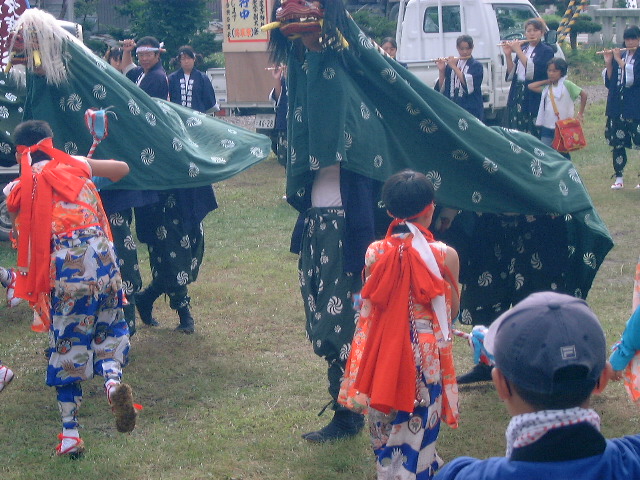
Dedicated at the annual festival of the Tadoshi Shrine in September (Photo courtesy of Fukagawa City)
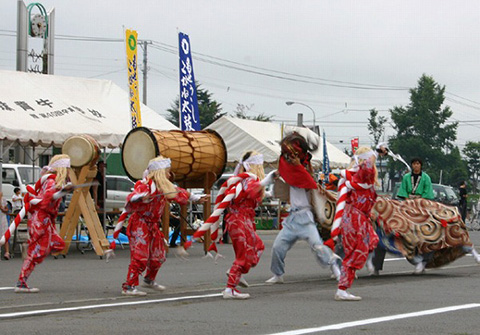
Represents a battle between an evil beast and a deity’s servant. Dedicated at the annual festival of the Moseushi Shrine in September. (Photo courtesy of Moseushi Town Lion Dance Preservation Society)
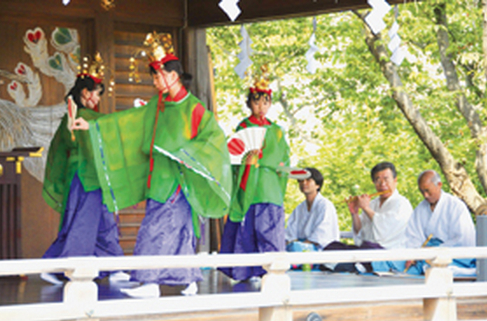
Performed at the festivals of the Muroran Hachimangu (August), Mikasayama (August), Wanishi (July) and Motowa Nishihachimangu (September) shrines (Photo courtesy of Muroran Mimpo)
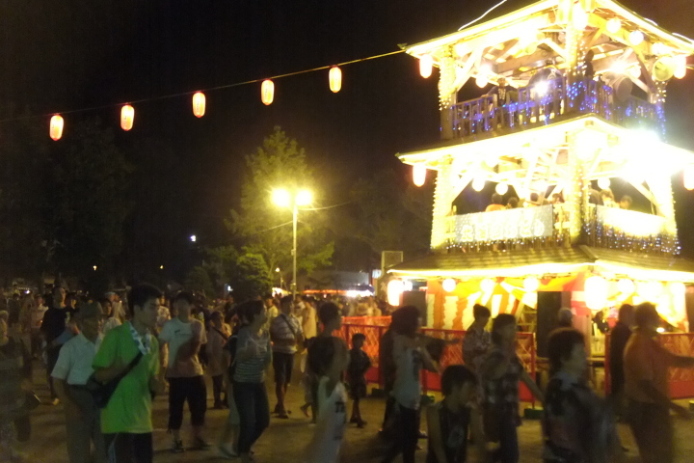
The Hokkai Bon Dance in Mikasa was designated as a Hokkaido heritage in 2001 as part of coal mine-related facilities and living culture in Sorachi. The national Hokkai Bon-uta singing competition is also held in the city. (Photo courtesy of Mikasa City)
Related link
- Culture of a coal mine town (Mikasa Geopark) (In Japanese)
Winter events recognized by the world

Held at three sites – Odori, Tsudome and Susukino – in early February every year (Photo courtesy of Sapporo Sightseeing Photo Library)
Hokkaido is a cold region with a heavy snowfall in Asia and the prefecture’s winter festivals attract attention from Asia and elsewhere in the world.
The Sapporo Snow Festival is the most attractive winter event, although it has a history of less than 70 years starting in 1950. The festival that now attracts as many as 2.4 million visitors annually started with only six snow statues that were built in Odori Park by local elementary and high school students. The Sapporo Snow Festival is now widely featured in overseas guidebooks and many overseas visitors come to the festival every year.
The Winter Festival in Asahikawa is famous for larger snow sculptures and a longer history than the Sapporo Snow Festival, dating back to 1946. Other popular winter festivals in Hokkaido include the fantastic Snow Light Path Festival in Otaru and the Hakodate Winter Festival, illuminations of light in Hakodate.
The Showa-shinzan International Yukigassen tournament in Sobetsu is a town revitalization event that started in 1989 to vitalize the town in winter when visitors are fewer than in other seasons. Yukigassen (snow ball fight) has developed into a worldwide sport and competitions and events are currently held in 10 countries based on the rules established for the Showa-shinzan International Yukigassen tournament. Besides snow festivals in Hokkaido, the Yukigassen tournament is an example of creative events that are globally recognized.

Held in early February every year. The large snow statue of 1994 was officially recognized as the largest snow structure by the Guinness Book of Records. An international ice sculpture competition is held concurrently. (Photo courtesy of Asahikawa Winter Festival Executive Committee)
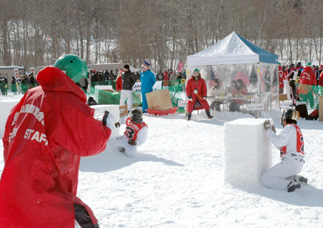
Winning teams of preliminaries held in Japan and abroad compete in late February. The event has also been designated as a Hokkaido Heritage. (Photo courtesy of Showa-shinzan International Yukigassen Executive Committee)
